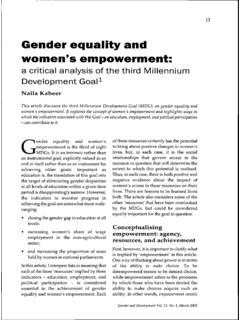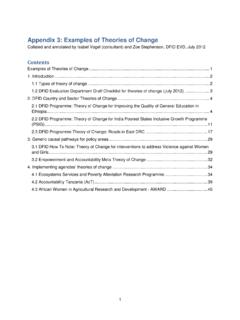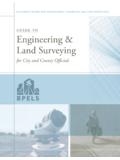Transcription of PRIMARY, SECONDARY & HIGHER SECONDARY EDUCATION
1 EDUCATION SYSTEM IN INDIA primary , SECONDARY & HIGHER SECONDARY EDUCATION In the Indian system, HIGHER EDUCATION includes the EDUCATION imparted after the 10 + 2 stage ten years of primary and SECONDARY EDUCATION followed by two years of HIGHER SECONDARY EDUCATION by the Government and the Public Schools (website ). In general the medium of instructions in India is English. English is widely spoken and understood in India. HIGHER EDUCATION SYSTEM IN INDIA Universities and specialized institutes are the centers for HIGHER EDUCATION in India. The studies and disciplines cover a wide range of subjects from poetry to computer engineering to space research. Most of the universities and HIGHER centers of learning and research are autonomous in function. A good number of universities have a federal structure composed of affiliated colleges on one tier and the university departments on the other.
2 There are a number of colleges and universities in India both government as well as private recognized by government, which are imparting academic and professional EDUCATION . Detailed and elaborate information on these colleges and universities can be accessed on the website of the University Grants Commission(UGC) COURSES AND DEGREES Undergraduate Courses Undergraduate courses, in general, are of three years leading to the final examinations. The universities and HIGHER institutes award Bachelor s degree in Arts, Science, Commerce, etc. However, undergraduate courses leading to a first degree in professional subjects like Engineering, Medicine, Dentistry and Pharmacy are of a longer duration ranging from four to five and a half years. Postgraduate Courses Courses in Arts, Science and Medicine usually last two years ending with a Master s degree.
3 For Engineering and Technology, the courses are for one and a half years. Specialized fields for instance, for a Bachelor of EDUCATION ( ) degree, the possession of a Bachelor s degree in any other discipline is required before admission can be obtained. Some universities and HIGHER institutes offer a diploma or a certificate course of shorter duration in disciplines like Engineering, agricultural Sciences and Computer Technology. The duration of these courses varies from university to university. Eligibility for Admission IMPORTANT: International students going to India for HIGHER EDUCATION must deposit tuition fee for one year to the concerned university/college. It may also be ensured that the foreign student has a minimum amount of US$ 2000 readily available to meet day to day expenses if the duration of course is for more than one year and US$ 1000 if the course is less than one year.
4 International students must register themselves with the Foreigners Regional Registration Office of the concerned state immediately on arrival in India( ). For admission to undergraduate courses, in the universities or institutions of HIGHER EDUCATION in India, the candidates need to complete 12 years of schooling having passed in 5 subjects in the Senior SECONDARY or equivalent examination with 60-70% marks in their qualifying examinations. For admission to undergraduate technical courses, the candidates should obtain 75-80% in their qualifying examinations which should include the subjects: Physics, Chemistry, Biology, Mathematics and English. Admission requirements to undergraduate pass courses are not very rigid. Admission in non-professional colleges is usually not difficult, except in the case of some selected colleges in metropolitan towns where there is strong competition.
5 Entry into professional colleges, in Medicine, Engineering, Pharmacy, Dentistry, Architecture, Management or Agriculture is difficult because of the limited number of seats available, and is generally based on a separate admission test. However, in some cases, overseas applicants can be admitted against nominated seats/paid seats according to prescribed guidelines of the Indian university concerned. Foreign students need to get their year 12 certificate equated by the Association of Indian Universities (AIU) which has been accepted as an accredited agency at the national level for undertaking the assessment/ for equating of foreign academic credentials with the Senior SECONDARY Examination (Class XII) in India and is considered to be the minimum admission requirement for the first degree programme ( ). Indian universities do not give blanket recognition to the degree/diploma/certificate awarded by foreign universities or educational boards.
6 International students wishing to study at an Indian university are advised to ascertain their eligibility from the Embassy or write to: Evaluation and Information Unit, Association of Indian Universities, AIU House, 16 Kotla Road, New Delhi 110002. Tel: 91-11-3230059/2305/3390/3097/2429 Fax: 91-11-3236105 The Evaluation and Information Unit of the AIU will evaluate the academic programme completed by the international student. ICCR SPONSORED COURSES The ICCR provides scholarship schemes for overseas students for doctoral, post-graduate, under-graduate courses as well as professional courses such as engineering, pharmacy, business administration and accountancy under the General Cultural Scholarship Scheme. However, scholarship for medical studies for MBBS, BDS or for medical research leading to a degree are not offered under the scheme( ).
7 Generally, ICCR offers two scholarships per year for students from Azerbaijan Academic Year The academic year usually begins in June or July and ends in March or April. Institutions located in high altitude areas (about one or two percent of the total) follow a different schedule, beginning in March and going on to December. In most universities which follow an annual examination pattern the academic year is divided into three terms. A few universities follow the semester system. There is no organized system of teaching during summer vacations. Examination System In case of universities following the annual pattern, an end-of-year examination is held between March and May and the results are declared two months later. Supplementary examinations are held in October or November. Universities following the semester system have examinations in November-December and March-April.
8 Most examinations are conducted by the universities; however, some affiliating universities have reduced the number of university examinations for a degree. For example, at the Bachelor s level in the humanities, the examinations at the end of the first year may be conducted by the college, and the ones at the end of the second and third years by the university. Centralised evaluation has also been adopted by some universities to save time in the evaluation of scripts. Internal assessment of the work done by the student throughout the year carries 10 to 25 percent of the total marks at the undergraduate level, and 20 to 40 percent at the postgraduate level in some universities. The Engineering, Medicine and Management institutions have generally adopted the internal assessment system completely, using a letter-grade and a credit point system. Medium of Instruction In most of universities the medium of instruction is English.
9 In case of professional courses, and for science and technical subjects, English is exclusively used for teaching. For the Humanities, Social Sciences and Commerce faculties, the medium of instruction is both in English and in regional languages. Postgraduate EDUCATION is conducted in English in most of the centers. Distance EDUCATION The EDUCATION through Correspondence course was started in Indian universities in 1962. In 1982 the first Open university was established at Hyderabad in Andhra Pradesh, and in 1985, the Indira Gandhi National Open University (IGNOU) was established at Delhi. Other Open universities have since been set up in the states of Rajasthan, Maharashtra, Bihar, Gujarat, Madhya Pradesh and Karnataka. 57 universities have correspondence course institutes.





